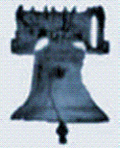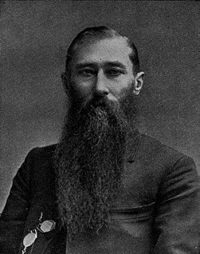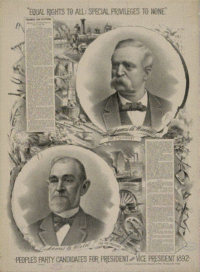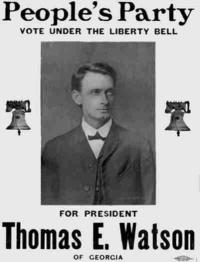 SKC Films Library SKC Films Library |
| SKC Films Library >> Political Science >> Political Institutions and Public Administration: United States > Political Parties |
 People's Party aka Populist Party The People's Party grew out of dissatisfaction with the way Democrats and Republicans alike were dealing with the financial crisis then affecting poor, white cotton farmers in the South (especially in North Carolina, Alabama, and Texas) and drought-stricken wheat farmers in the Plains (primarily Kansas and Nebraska).
left: 1892 People's Party campaign poster The party's decline began following the 1892 election. Some of the party's problems stemmed from fraud, intimidation, and violence by Southern Democrats, but most of them arose from within the party itself, as its membership began to split into two main factions. One faction, known as "fusionists," sought a merger with the Democratic Party and was willing to compromise on most issues. The other faction, known as "mid-roaders," strongly opposed merger with any other party and was not open to compromise on any issue. Although this faction publicly advocated staying the "middle ground" between Democrats and Republicans, it was actually far to the right and left of both. The rift between the fusionists and mid-roaders even extended to the choosing of a date for the 1896 People's Party National Convention. The mid-roaders wanted the convention to be held before those of the Republicans and Democrats, but the fusionists wanted it to come after. The fusionists ultimately won, and the convention was scheduled for July 24-26, in St. Louis; the Republican Convention was held in St. Louis June 16-18, and the Democratic Convention in Chicago July 7-11. Fusionists still held most of the power when the People's Party met in St. Louis, and were successful at getting the majority of the delegates to agree that the party's interests would be best served by supporting the Democratic candidacy of William Jennings Bryan, leader of the free-silver movement. The fusionists thought they had an agreement with Bryan whereby he would name Tom Watson, editor of the People's Party Paper, as his running mate, but Bryan instead chose Arthur Sewall. Many in the People's Party refused to campaign for Bryan, while many others simply agreed to not campaign against the ticket; few in the party enthusiastically backed the Bryan-Sewall ticket, which ultimately lost the election to William McKinley and Theodore Roosevelt.
right: 1904 People's Party campaign poster SEE ALSO |
| SKC Films Library
>> Political Science
>> Political
Institutions and Public Administration: United States > Political
Parties This page was last updated on 06/07/2017. |
 In December 1888, the
National Agricultural Wheel and the Southern Farmers'
Alliance met at Meridian, Mississippi, and agreed to
merge as the Farmers and Laborers Union of America. The
agreement was ratified by 1889, except in Texas and
Arkansas; those two states finally agreed to the merger
in 1890 and 1891, respectively. Populists won control of
the Kansas and Georgia legislatures in 1890, and William
Peffer (right) and Tom Watson became the party's
first U.S. Senators, for Kansas and Georgia,
respectively.
In December 1888, the
National Agricultural Wheel and the Southern Farmers'
Alliance met at Meridian, Mississippi, and agreed to
merge as the Farmers and Laborers Union of America. The
agreement was ratified by 1889, except in Texas and
Arkansas; those two states finally agreed to the merger
in 1890 and 1891, respectively. Populists won control of
the Kansas and Georgia legislatures in 1890, and William
Peffer (right) and Tom Watson became the party's
first U.S. Senators, for Kansas and Georgia,
respectively.
